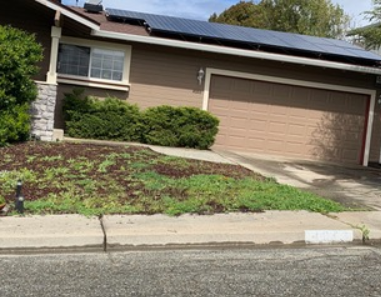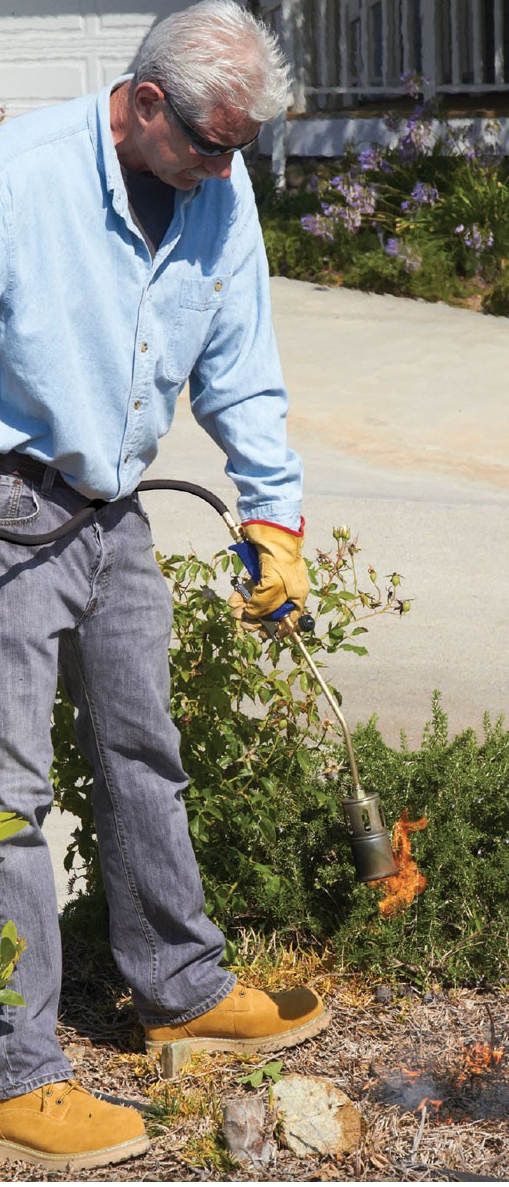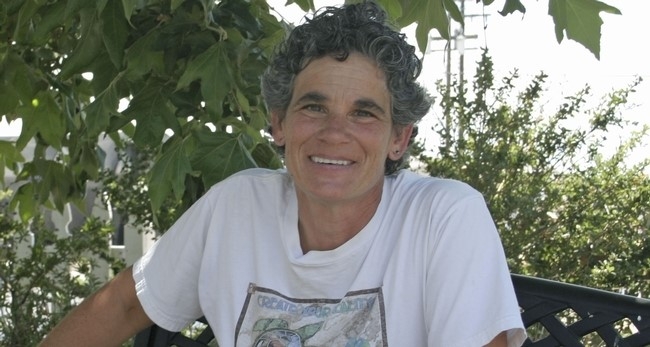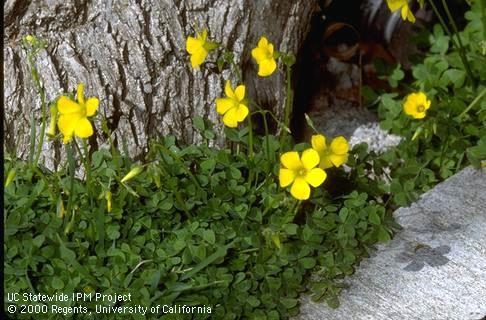Advice for the Home Gardener from the Help Desk of the
UC Master Gardener Program of Contra Costa County
Dear Help Desk: I'm writing to try to figure out the best approach to “fixing” our front yard: 4 years ago we pulled up the lawn and laid down weed block and put redwood chips on top. The weeds still spring up, and this year has been particularly bad. The wood chip “lawn” has essentially been overtaken by weeds. We'd like to retain the wood chip “lawn” in this part of the yard. Do you have suggestions for a fix? Should we just pull up the weeds and add 6” more wood chips as has been suggested by a friend?

1) Removing all the weeds currently growing. This ideally would be done by hand weeding, but you may also consider the use of herbicides. Which herbicide would work best is going to depend on the specific weed. If you need help identifying specific weeds, you can use the link below and we can provide help as well.
2) You may then want to water the area, wait for the weeds to germinate and then remove them while they are small. Doing this repeatedly a few times will greatly reduce your weed population long term.
3) Once you have adequately prepared your site, you will want to install a weed barrier. Ideally you want to use something organic that will decay such as cardboard or burlap. However, you may also try landscape cloth again.
4) After applying your weed barrier you will want to cover the barrier with 1-5 inches of mulch. The amount of mulch needed depends on which barrier you select. Landscape fabric requires less mulch than organic barriers.
5) This will not prevent all weeds and will need ongoing management. You will want to continue to remove weeds as early as possible, ideally by hand weeding. As your mulch breaks down, it also creates an organic layer that is very amenable to weed growth. The mulch layer does need to be periodically refreshed.
The following references may be helpful as you revitalize your front yard. It is certainly understandable that you want just mulch and no plants in your front yard, but it may be worth considering that putting desired plants into your yard will also help decrease weeds by competing for resources (sun, water, nutrients). Once you have eliminated these weeds, you may want to consider putting in some succulents or low-water native plants which may reduce the maintenance you need to do long-term.
http://ipm.ucanr.edu/PMG/PESTNOTES/pn7441.html
http://sacmg.ucanr.edu/files/163135.pdf
http://ipm.ucanr.edu/PMG/weeds_intro.html
Best of luck with your lawn and let us know if we can help further.
Help Desk of the UC Master Gardener Program of Contra Costa County (SES)
| Don't miss our 2019 Great Tomato Plant Sale - Antioch 4/13. Click here for more information>>: http://ccmg.ucanr.edu/tomato/ |
Note: UC Master Gardeners Program of Contra Costa's Help Desk is available almost year-round to answer your gardening questions. Except for a few holidays (e.g., last 2 weeks December), we're open every week, Monday through Thursday for walk-ins from 9:00 am to Noon at 2380 Bisso Lane, Concord, CA 94520. We can also be reached via telephone: (925) 608-6683, email: ccmg@ucanr.edu, or on the web at http://ccmg.ucanr.edu/Ask_Us/. MGCC Blogs can be found at http://ccmg.ucanr.edu/HortCoCo/ You can also subscribe to the Blog.
Advice for the Home Gardener from the Help Desk of the
UC Master Gardener Program of Contra Costa County
Client's Request: I've heard that I can use yellow corn meal to control weeds. Is this doable and will it hurt the soil?
Help Desk Response: Thank you for contacting the UC Master Gardener Program Help Desk with your question about cornmeal and weeds. I am going to assume that you mean corn meal gluten (CGM), a by-product of corn starch manufacturing that is marketed to home gardeners for pre-emergent control of weeds, especially in lawns. Yellow corn meal makes great polenta, but won't do much for weeds!
University of California research has not shown CGM to be an effective weed control strategy, but in a lawn, it may work because it is high in nitrogen and will feed the lawn, making it more dense, and likely crowding out weeds. Lawns already fed with high nitrogen fertilizers probably won't show any significant benefit from CGM.
CGM will have no effect on already-emerged weeds; it only suppresses some seeds' ability to sprout. It is sometimes used though where only organic herbicides are permitted, but its effectiveness is still questionable. It should not have adverse effects on soil. Because it is high in nitrogen, it could be beneficial if your soil is deficient in that nutrient.
Better weed control can be achieved by heavily mulching the area, which will prevent weed seeds from sprouting. At this time of the year, late winter, when many of our weeds have already come up, you can try hand-pulling or hoeing out the small weeds. They are always easiest to control when they are small. This link will give you great information from UC about weed management in the landscape: http://ipm.ucanr.edu/PMG/PESTNOTES/pn7441.html. The key to successfully reducing the weed problem in future years is to make sure none of this year's weeds go to seed.
Weeds in our gardens are frustrating and seem to be extra-abundant this year because of all the rain we've had. Good luck!
Help Desk of the UC Master Gardener Program of Contra Costa County (SEH)
Don't miss our 2017 Great Tomato Plant Sale:
http://ccmg.ucanr.edu/EdibleGardening/GreatTomatoPlantSale/
Note: The UC Master Gardeners Program of Contra Costa's Help Desk is available year-round to answer your gardening questions. Except for a few holidays, we're open every week, Monday through Thursday for walk-ins from 9:00 am to Noon at 75 Santa Barbara Road, 2d Floor, Pleasant Hill, CA 94523. We can also be reached via telephone: (925) 646-6586, email: ccmg@ucanr.edu, or on the web at http://ccmg.ucanr.edu/Ask_Us/ MGCC Blogs can be found at http://ccmg.ucanr.edu/HortCoCo/ You can also subscribe to the Blog (http://ucanr.edu/blogs/CCMGBlog/).
Advice for the Home Gardener from the Help Desk of the
UC Master Gardener Program of Contra Costa County
Client's Request: As we discussed on the phone this morning, I have recently installed extensive drought-resistant landscaping. I have also added wood chip mulch to prevent weeds. However, I'm concerned about how to maintain it weed-free as well as other areas in my garden. Our phone discussion covered many of the usual techniques to prevent weeds in this situation. You said that you would do some further review and possibly provide me with some more options.
UC MGCC Help Desk Response: Thank you for contacting the UC Master Gardener Program Help Desk with your questions about weed control in your new landscape.
The first option is to put down a weed fabric (not plastic) on the edges of your landscaping to control the small, sneaky weeds that appear where the wood mulch tends to be thin. Once the fabric is installed, you can cover it back up with your wood mulch. This will stop the weeds from coming up on the edges of your pathways.
Another option we didn't discuss is using a weed flamer. Flamers require no chemicals, and don't result in groundwater contamination or chemical residues on garden. One plus for weed flamers is that they are usually considered an organic gardening method. For effective weed control, you can use flamers in spring and early summer as annual and perennial weeds emerge. Killing larger, mature plants requires more heat, so save time and fuel by flaming weeds when they're still young and tender. This is a good option for larger areas that need treatment.
You can Google ‘weed flamer' for local and online suppliers as well as additional safety guidance. The idea of weed flamers isn't to burn the plants, but to quickly pass over to apply the right amount of heat to cause the water in the weed cells to boil, causing the plant to atrophy and die. Torch remaining weeds once every two to three weeks in ongoing applications or as needed until the next frost. Flaming kills annual weeds completely but does not completely eradicate the roots of perennial weeds.
If you do decide to use a flamer, be sure to keep a water supply handy, and do not get the flame near anything flammable, especially your dry wood mulch back, for safety purposes. To be safe, you may need to pull the mulch back before using the flamer or drench the mulch first with water.
Here is a link to more (and extensive) information on weed control in your garden:
http://www.ipm.ucdavis.edu/PMG/PESTNOTES/pn7441.html
Please don't hesitate to give us a call if you have additional questions!
Help Desk of the UC Master Gardener Program of Contra Costa County (SLH)
Note: The UC Master Gardeners Program of Contra Costa's Help Desk is available year-round to answer your gardening questions. Except for a few holidays, we're open every week, Monday through Thursday for walk-ins from 9:00 am to Noon at 75 Santa Barbara Road, 2d Floor, Pleasant Hill, CA 94523. We can also be reached via telephone: (925) 646-6586, email: ccmg@ucanr.edu, or on the web at http://ccmg.ucanr.edu/Ask_Us/ MGCC Blogs can be found at http://ccmg.ucanr.edu/HortCoCo/ You can also subscribe to the Blog (http://ucanr.edu/blogs/CCMGBlog/).
Advice from the Help Desk of the
UC Master Gardener Program of Contra Costa County
i confess ... I'm a garden blog junkie.
As an avid gardener, I'm also looking to the (many) blogs I subscribe to for ideas on how to enjoy my gardening even more. While I hope you find this blog interesting, there are many other UCANR blogs that you might be interested in as well. Many of the most informative are posted quite frequently, while most are only posted occasionally. You can find the full list of UCANR blogs at http://ucanr.edu/blogs/blogcore/blogroll.cfm?sort=a. You will probably have to do some looking around to find blogs you will be interested in… but you can easily change your subscriptions at any time.
A recent blog I subscribe to -- UC WEED SCIENCE had some great advice on getting rid of garden weeds:
*************************************
Control garden weeds in early spring
Posted by: Gale Perez
Published on: April 14, 2016....From the UCANR News Blog...
UC Cooperative Extension IPM advisor Cheryl Wilen recommends swivel hoes over herbicides for weed control.
Wilen recommends home gardeners use a swivel (or hula) hoe to scrape the surface and decapitate weeds. “It's a bit of exercise,” she said, "but you can do it so quickly, it's not a problem.”
Another weed control strategy is a thick layer of mulch, with does double-duty by reducing water evaporation from the soil surface, thereby conserving water.
Wilen suggests a three- to four-inch layer of mulch be spread in garden beds and landscape borders before the weed seeds have a chance to germinate. Mulch blocks the sunlight weeds need to push through the ground.
Fabric weed barriers are useful for controlling particularly challenging weeds, like nutsedge. Wilen suggests covering the fabric with mulch for an esthetically pleasing weed-free garden.
Though the common herbicide glyphosate (such as Roundup) kills weeds and is safe if used correctly, Wilen prefers using the swivel hoe. "It's just quicker and easier than pulling out the spray equipment," she said.
************************************
No use re-inventing the wheel for this blog with this advice… time to get out my hula hoe… and I found the link to the LA Times article informative as well.
So… for all you garden junkies out there… you might consider perusing and subscribing to some UCANR blogs to get your full daily “garden fix”.
UC Master Gardener Program's Help Desk
Note: The UC Master Gardeners Program of Contra Costa's Help Desk is available year-round to answer your gardening questions. Except for a few holidays, we're open every week, Monday through Thursday for walk-ins from 9:00 am to Noon at 75 Santa Barbara Road, 2d Floor, Pleasant Hill, CA 94523. We can also be reached via telephone: (925) 646-6586, email: ccmg@ucanr.edu, or on the web at http://ccmg.ucanr.edu/Ask_Us/ MGCC Blogs can be found at http://ccmg.ucanr.edu/HortCoCo/ You can also subscribe to the Blog (http://ucanr.edu/blogs/CCMGBlog/).
Advice for the Home Gardener from the Contra Costa Master Gardeners' Help Desk
Client's Problem and Questions:
Advice from the CCMGs' Help Desk
"Researchers around the world are investigating approaches for controlling Bermuda buttercup. Some suggest covering infestations with stiff cardboard, then covering the cardboard with a thick layer of organic mulch to kill the plants and weaken the bulbs, making them less capable of competing with desirable plants. Keep the mulch on the infestation until the mulch and cardboard have rotted, then plant competitive ornamentals into the soil-mulch mixture."
The Contra Costa Master Gardener article, "Oxalis: From Ornament to Nuisance" will give you even further insight on controlling Oxalis per-caprae. http://ccmg.ucanr.edu/files/83817.pdf
I know that the management of these weeds is a big challenge and wish you all the best in dealing with it!
Contra Costa Master Gardeners' Help Desk
Note: The Contra Costa Master Gardener Help Desk is available year-round to answer your gardening questions. Except for a few holidays, we're open every week, Monday through Thursday for walk-ins from 9:00 am to Noon at 75 Santa Barbara Road, 2d Floor, Pleasant Hill, CA 94523. We can also be reached via telephone: (925) 646-6586, email: ccmg@ucanr.edu, or on the web at http://ccmg.ucanr.edu/Ask_Us/

